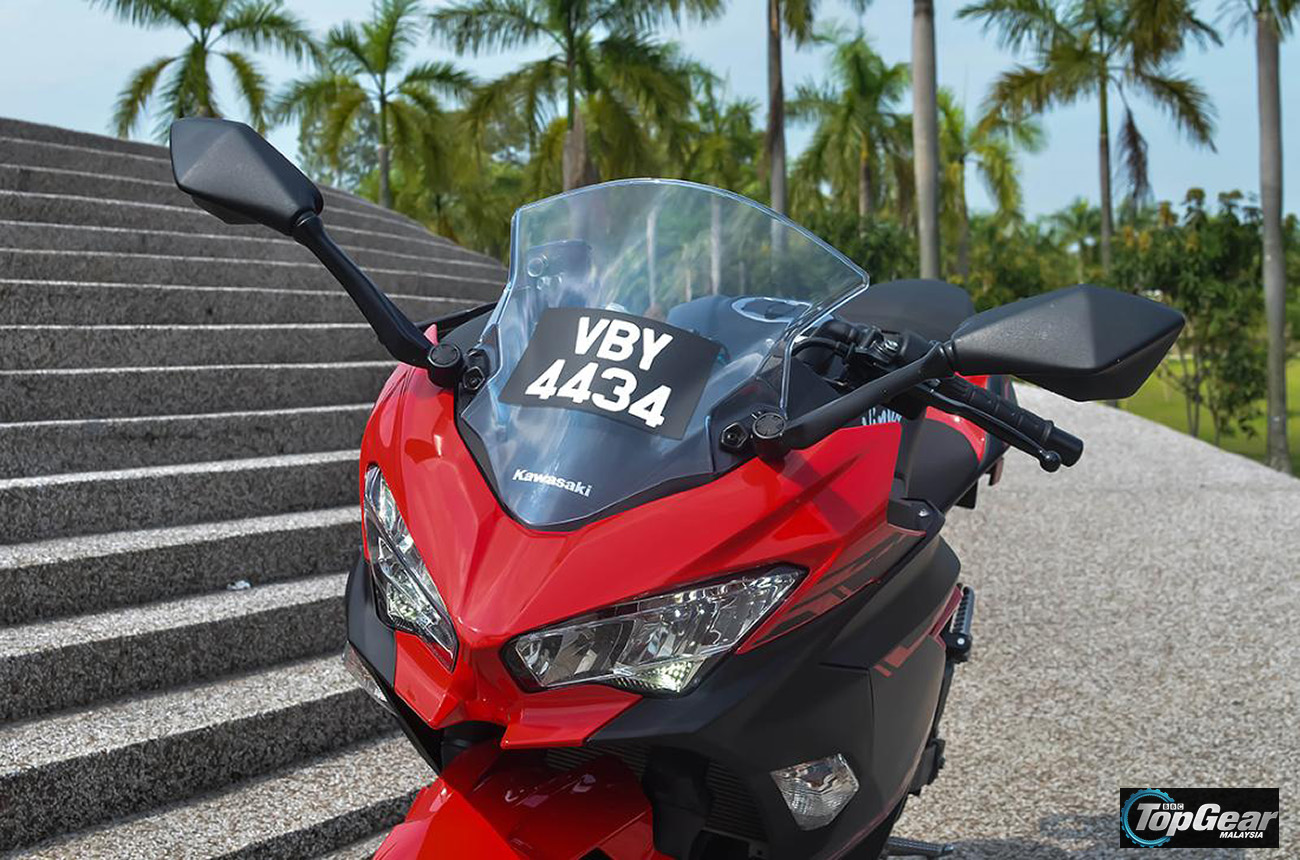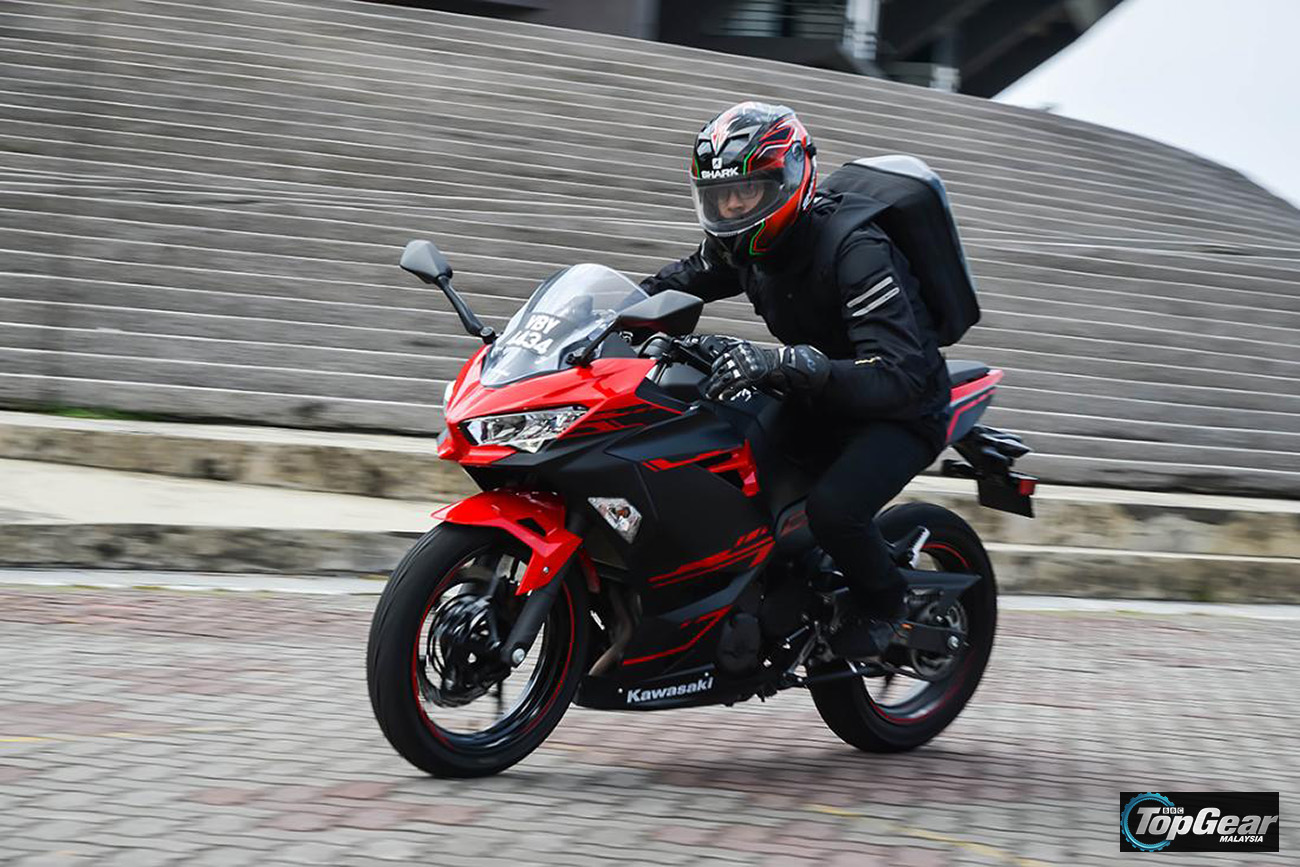
Rewind back three years and many will remember just how dominant the Kawasaki Ninja 250 was. It was especially so among fresh B licence holders and those upgrading from their trusty kapchai commuters.
But it didn’t take long before the competition strengthened, more so when Yamaha unleashed the YZF-R25. Clearly, then, the Ninja 250 was put at a disadvantage, especially in styling. All that changed once this new, redesigned replacement appeared this August.
The Ninja 250’s looks have evolved completely, taking plenty of cues from the bigger Ninja 650 sport standard as well as supersport siblings ZX-6R and ZX-10R. In the process, Kawasaki claims, it has become more aerodynamic too.
Awkward positioning of the side mirrors aside, there’s still plenty to love all around. The eye candy includes racy vents in the fairings, modern full LED lights front and aft, not forgetting the racy red-black colourway of our test unit. This new machine has certainly outdone its predecessor.

Hop into the hot seat and it gets even better. Unlike its predecessor, the ergonomics feels more compact and sportier. Much of this has resulted from its slimmer and smaller new 14-litre tank and raised 795mm seat height.
To complement that, the new, fully digital instrument panel has all the necessary readouts one could ever need, gear position included. All the controls are where you’d expect them to be and, like the bike it replaces, the new Ninja 250 retains its sports standard ergonomics, favouring a more upright, comfortable riding position instead of the low, forward crouch most supersports dictate.
The biggest change is in the oily mechanical bits behind its fairings. We’re talking, of course, about its beating heart and the lighter new chassis which encases it. Like before, the engine is a liquid cooled, 249cc DOHC parallel twin primed with eight valves and electronic fuel injection.
However, unlike before, the new-for-2018 model sees its mill retuned for both higher revs and output. Sure, 38.2bhp at 12,000rpm and 23.5Nm at10,000rpm don’t sound like much, but these figures place the Ninja 250 at the top of the food chain in its segment in this aspect.
Much of the mill’s improvements become more obvious on the move. In contrast to its predecessor, it’s now more efficient, richer in torque from 4,000rpm onwards and has greater top-end power. However, you still need to work the throttle hard to go fast, but it’s clearly easier with this new machine.
Thankfully, what’s also improved is the assist & slipper clutch hardware of its 6-speed box. The lightened clutch weight short release action will take some getting used to, but it has resulted in slicker and more precise shift action through all six cogs, something to delight newbies and the experienced alike.
Having ridden it in both urban and non-urban traffic throughout the recent Merdeka holiday weekend, we know the Ninja 250’s ride and handling is also something many will appreciate. Though it arguably isn’t as sharp at corner-carving as the rival Yamaha, it will keep up nonetheless thanks to its slightly lighter 164kg claimed kerb weight.
What’s surprisingly pleasant are the suspension and dampers, which have been set to provide balance for all occasions. Up front, a pair of new 41mm telescopic forks works in tandem with a single gas-charged shock plus Bottom Link Uni-Trak setup at the rear, the latter boasting pre-load adjustments too – quite typical of bikes in this segment.

In this area, the Ninja 250 sees more of an evolution than a revolution, the ample amounts of travel and damping easily keeping any commute through the urban jungle’s pothole-ridden roads comfortable, even when riding with a pillion. And yet, there’s still enough dynamic athleticism to keep upstart weekend warriors happy on a tight, twisty B-road.
As reassuring are the Ninja 250’s anchors. There’s a larger new 310mm semi-floating disc up front now instead of the predecessor’s 290mm unit. That, plus the 220mm disc at the rear, is grabbed by dual piston callipers, offering a strong bite without needing too much effort with the levers.
While we’re on stopping ability, it’s hard to ignore the absence of ABS in the ‘standard’ Ninja 250. But fret not, Kawasaki Motors Malaysia Sdn Bhd has promised to roll out an up-specced, ABS-equipped variant soon alongside the global-spec Ninja 400 machine, complete with all the bells and whistles – more on that when they arrive.
For now, though, if you want a good starter bike to kick off a lifetime of riding, the Kawasaki Ninja 250 is not only prettier and arguably faster, but also a much better all-rounder than before.
Price? RM23,071 (sans on-road costs). Perhaps a bit on the high side, but a worthwhile buy, we think.




























Not the fastest or sharpest, but beefed up power and sharp, new styling are enough to make this an excellent starter bike.
An arguably sportier rival with equally good looks.
SPECS
| Engine | Liquid cooled, 249cc DOHC parallel twin, 38.2bhp, 23.5Nm |
| Price | RM23,071 |
| Fuel tank | 14 litres |
| Transmission | 6-speed return manual chain drive with assist & slipper clutch |
| Weight | 164kg (kerb) |

